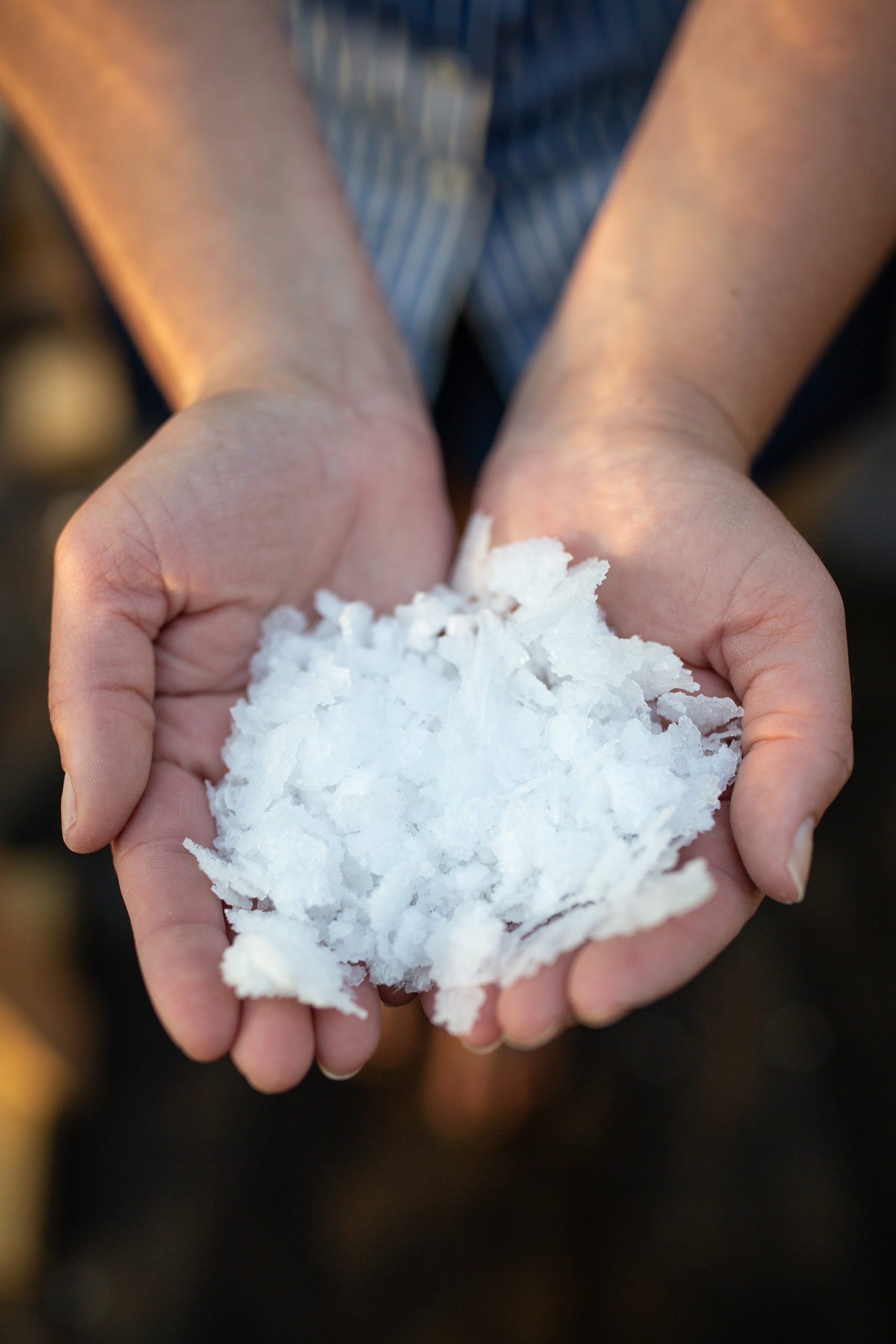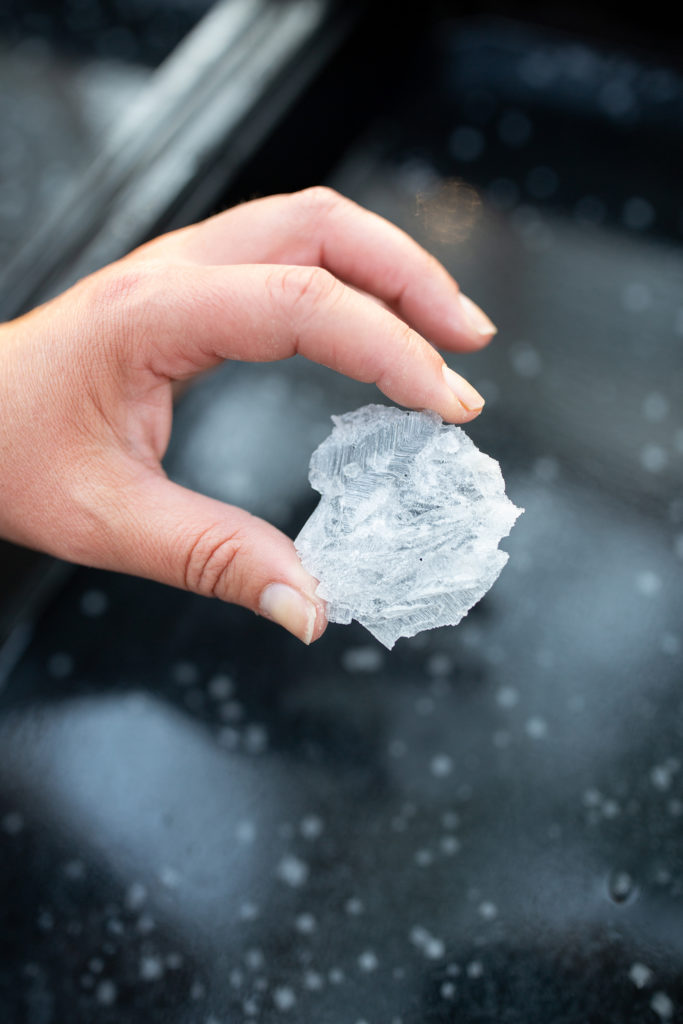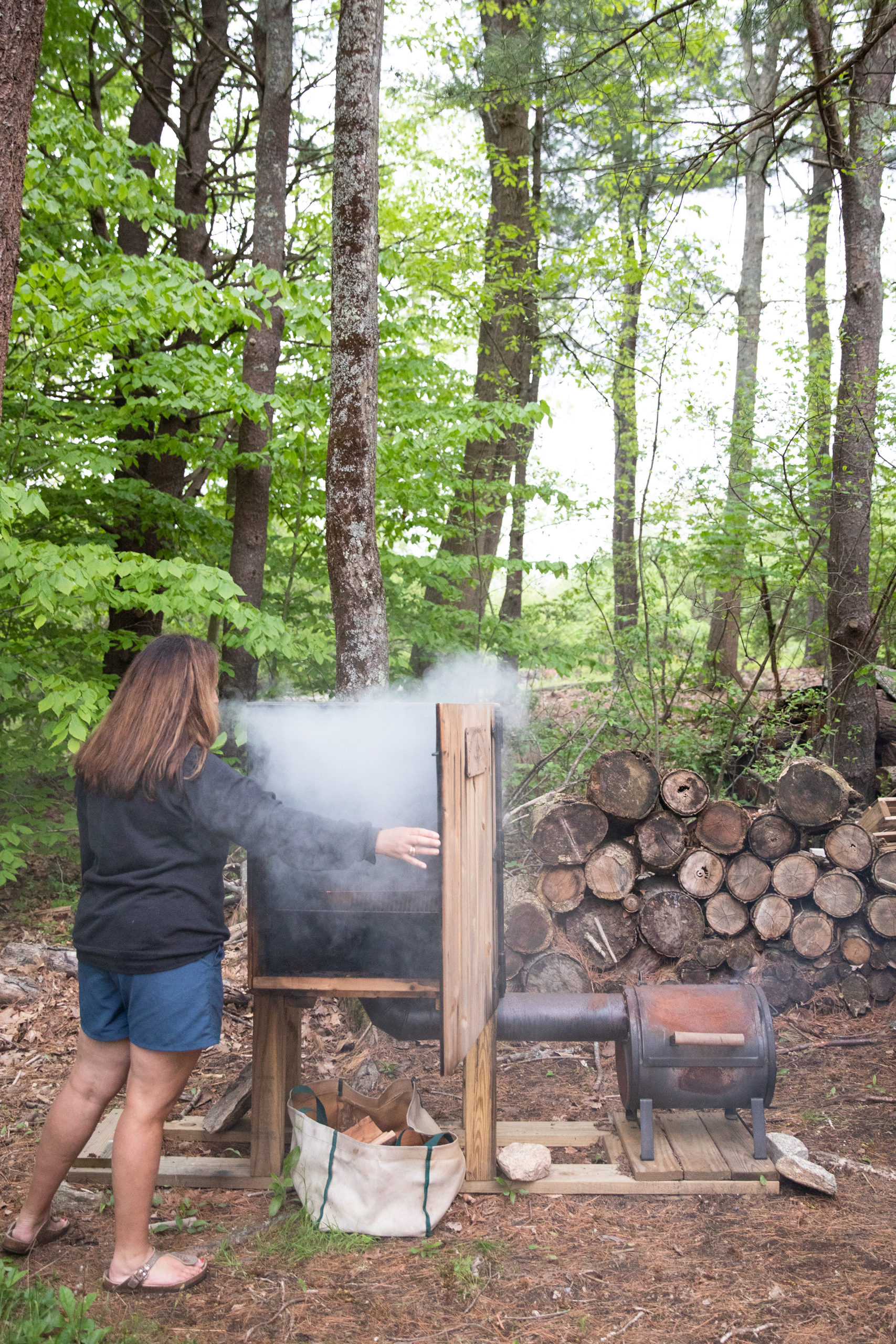World-Class Flake Salt Fresh From the Coast
Slack Tide Sea Salt, a women-run business off the coast of York, makes unparalleled finishing salt by hand.

Why sea salt is not famous for its pyramidal crystals is a mystery. They are miraculous. Given the right conditions, halite grows outward in concentric squares to create hollow pyramids. This ecstatic expression of nature, called “hopper crystals” when other minerals make it and “flake salt” when it’s halite, is highly coveted by gourmands the world over. You don’t toss flake salt in pasta water. You don’t whip it into batter. The flake is for finishing a dish. It is the proverbial cherry on top, only less proverbial and more literal. It is the zing, the wow, the powerful and, yes, salty crunch of a perfect pyramid of sodium chloride.
Lauren Mendoza, co-owner of Slack Tide Sea Salt out of York, holds a handful of these geometric wonders in her open palm. “It does not get old,” she says, referring to the process of turning seawater collected just a few miles beyond her back door into flakes of salt. “Every time I make a batch, I zone out and stare at it, lovingly,” she says. “They dance around the surface of the brine until they’re heavy enough to drop, like really fine snow.”
Not every flake is a perfect pyramid, of course. A jar of Slack Tide’s finishing salt resembles crushed ice only flatter, each piece ranging from itty-bitty to half an inch. But dump it in your own palm and you’re bound to find a few intact hoppers.


Why don’t we see salt like this all the time? Though the pyramid shape is a natural expression of sea salt, it’ll only occur given very specific conditions. In other words: anyone can make flake salt, but very few can—and very few do—make flakes like this. And the process is hard to scale. “The texture is so important,” says Mendoza. “It does distinguish it from other salts. It’s a process that takes quite a bit longer and is more hands-on.”
Mendoza grew up in York; she knows its waters and has been harvesting seawater to turn into salt for years, but it was only in 2020 that she made it a business, launching Slack Tide with her aunt, Cathy Martin, and her best friend, Sarah Caldwell. “It is 100 percent women owned,” says Mendoza. “Our family helps, but it’s run by women.” Women make the decisions, and women oversee the process from start to finish.
It begins in a Carolina Skiff, “a workhorse of a boat,” motored downriver to the ocean when the tide is high and just before it goes slack—that “peaceful transition between the tides.” Collecting at high tide is key: Mendoza believes that’s when the water is cleanest. “You’re taking this raw product and concentrating it,” she says. “One gallon [of seawater] makes three, four ounces of salt. In my mind, if we’re getting the freshest seawater, that’s going to make the difference in quality.”

Disastrously, our oceans have become dumping grounds, so it pays to be careful. When collecting seawater, says Mendoza, “I like the idea of not being in the vicinity of 150 bathers covered in sunscreen, peeing.” And, knowing where their water has been is a way to stand by the product. Starting up around Nova Scotia, water is escorted southwest by the Western Maine Coastal Current and joined along the way by all the rivers that stripe the state, making a nutrient-rich stew off the coast of southern Maine. “Each region [of salt-producing ocean]is going to have its unique flavor profile,” says Mendoza. In the industry, the term for this is merroir— replacing the ter (earth) in the terroir with mer, for the sea. For an oyster or salt, the merroir is the taste of an origin story.
Production happens year-round. Hot weather is good for evaporation, but the deep cold offers brine rejection—when ice forms in the ocean, the salt is “rejected,” or pushed into the surrounding waters, concentrating its natural brine. “We are very much at the whim of Mother Nature,” says Mendoza. If there’s no sun, if the ocean’s choppy, if it rains too much, production slows.
In the skiff, seawater is pulled up using a hose connected to a small pump, at which point it gets its first rough filter (one of three) and is collected in 55-gallon drums. Back home, it moves from drums to a series of black plastic trays two, four, or six inches deep; “four inches deep is the sweet spot” in terms of speed-to-yield ratio, says Mendoza. The filtered seawater stays in the greenhouses on Mendoza’s property until it’s reached 80 percent evaporation and has become brine. To the untrained eye, brine could pass for sea salt, albeit wet and a bit soupy, but it can taste chalky or bitter because of the calcium and magnesium that has yet to be filtered. At this point brine is given a last nudge in electrically heated metal tubs. It’s during this step that the “magnesium kicks,” and the pyramidal flakes emerge. For Slack Tide’s line of seasoned salts (with names like Upta Camp, 207, and Bold Coast, a.k.a. Bloody Mary Sea Salt), the flakes will be mixed with ingredients like freshly grated lemon zest, dill, pepper, rosemary, kelp, or blueberry. They are available for purchase on the Slack Tide website, alongside an array of brand merch, like T-shirts with the words “Salty” or “Flaky” emblazoned across the front. The flakes can also be tasted at a handful of local restaurants, such as Regards in Portland and the recently opened Fish and Whistle in Biddeford, or purchased in shops such as Browne Trading Company in Portland, Trove in Searsport, Swallowfield in Northeast Harbor, and the Blue Barren Distillery in Camden.


seawater could pass for glamping outposts nestled between the tall trees of York.
Slack Tide’s salt was immediately well received, says Mendoza, and three seasons in, operations are scaling up. As of this writing, Slack Tide was about to build its fifth greenhouse with the hope of hitting six by the end of the year. But they want to “grow naturally, and not too fast.” It’s all about quality, not quantity.
This is part of an overall awareness and strategy that’s cooked into Slack Tide: an aim to do good for the earth too. Slack Tide is a member of 1% for the Planet, which helps businesses give to environmentalnonprofits,andbystayingsmallSlackTidecan continue making every batch entirely by hand.
Recently, the town of York granted Mendoza a commercial mooring license, traditionally reserved for fishing and lobstering. The mooring in York Harbor will make Slack Tide’s operations more efficient, eliminating the leg of the journey between Mendoza’s property, where the boat is typically docked, and the sea, but Mendoza also views this as an important development in the perception of aquaculture. “It’s the first step in adjusting verbiage to include other forms of sustainable practices of a working waterfront,” she says.
To say it’s a labor of love is to lean on cliche, but to call Slack Tide and its crew the salt of the earth is all too apt.
- Designed to Flow

- Maple Madness

- How to Keep Your Houseplants Alive This Winter

- The Best Ski Gear From Maine

- A Historic West End Brownstone Gets a Classic Renovation


